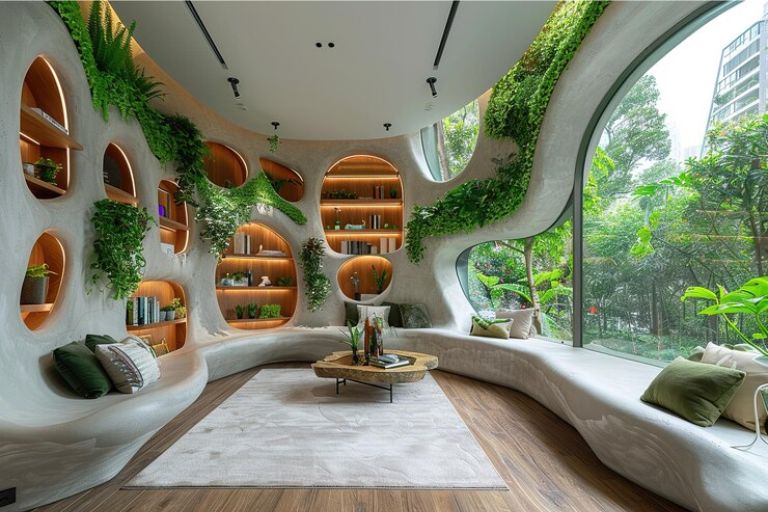The Beauty of Biophilic Design in Modern Times: Integrating Nature and Architecture
To the wonderful world of biophilic design – where nature meets innovation to create spaces that are not only beautiful but also beneficial for our well-being!
In today’s fast-paced, technology-driven world, reconnecting with nature has never been more important, and biophilic design offers a solution by bringing the outdoors in. We spend the majority of our time indoors, with limited travel between home and work, hindering our ability to fully enjoy the natural world. However, our innate desire to connect with nature, dating back to our days as hunter-gatherers, has led to the incorporation of biophilic designs in our urban environments.
After all, nature has a way of inspiring us all, so let’s dive in and discover the magic of biophilic design together!
Biophilia suggests that humans have a natural tie to nature as they rely on it for survival. Biophilic design integrates natural elements to enhance people’s connection to nature, using either direct or indirect experiences such as tangible contact or representations like images and natural materials.
WHAT IS BIOPHILIC DESIGN?
Biophilia is the natural inclination to form connections with nature, stemming from the Greek term ‘Philia’, meaning ‘love of’ or affection for living things. This idea was popularized by biologist Edward O. Wilson in his book Biophilia, suggesting that humans possess an inborn desire to interact with the natural world. Evidence of biophilic design can be traced back to ancient structures like the Hanging Gardens of Babylon and the Alhambra of Granada.
Today, the concept of biophilia is a growing design trend that aims to enhance our exposure to green spaces through a variety of sensory experiences. Biophilia plays a crucial role in pushing forward the green architecture movement due to its strong bond to nature-
1) Biophilic design improves energy efficiency by incorporating elements such as strategically positioned windows and outdoor spaces to utilize natural light and enhance ventilation in biophilic structures. This sustainable architectural approach reduces reliance on artificial lighting and heating, leading to decreased energy consumption in alignment with sustainable building design principles.
2) Preservation of biodiversity Eco-friendly architecture focuses on preserving and restoring local ecosystems. Biophilic design promotes this by incorporating native plants and wildlife-friendly elements, turning buildings into habitats that harmonize with local plants and animals.
3) Innovation in Sustainable Materials is driven by a mutual respect for nature in biophilic design and green architecture, leading to the use of natural materials and textures. This fosters creativity in sustainable architecture, promoting eco-friendly building practices.
BIOPHILIC DESIGNS FOR OUR HOMES
Pinterest’s 2022 trend report highlighted the biophilic design, with a rise in nature-inspired elements like Earthy neutrals, sustainable décor, daylighting, vegetation, organic textures, and handmade items. This trend aims to create an indoor-outdoor connection in interior spaces for a more natural feel. Consider incorporating these ideas for a biophilic interior design.
THE ESSENCE OF BIOPHILIC DESIGN
Biophilic design suggests that humans have an innate connection to nature, integrating natural elements into buildings to enhance well-being. Architects focusing on biophilic design create environments that promote happiness, health, and productivity by linking individuals to the natural world.
It brings-in Nature
Biophilic design suggests incorporating natural elements like wood, stone, and plants in interiors. Picture entering a space filled with greenery in an office or plant-covered courtyard in a home. These elements improve indoor air quality, aesthetics, and peace.
It Enhances Natural Light and Views
Incorporating natural light and nature views is crucial in biophilic design. Skylights, big windows, and well-placed openings bring in daylight, reducing the need for artificial lighting. Looking out at parks, gardens, and water features can enhance mental well-being and efficiency.
It incorporates Multisensory Experiences
Biophilic design involves engaging all senses, not just vision. By incorporating the sound of moving water, the feel of natural materials, and the scent of plants, a multi-sensory experience can be created to connect individuals with nature. Water elements and textures of natural wood or stone can provide soothing sounds and tactile sensations, respectively.
It is Sustainable
The combination of sustainability and biophilic design is becoming increasingly popular among architects. Utilizing techniques like green roofs, rainwater harvesting, and energy efficiency can result in structures that have a positive impact on both people and the environment.
It aids Health and Wellness
Many studies indicate that incorporating biophilic elements in architecture can enhance both physical and mental health. Hospitals built with biophilia in mind help lower stress levels, improve cognitive function, and expedite healing. Architects have the opportunity to encourage healthier habits through their design choices at a time when well-being is a top priority.
HOW TO IMPLEMENT BIOPHILIC DESIGN?
When incorporating biophilic design to enhance your space, it is important to think about natural materials, textures, patterns, and colors. Consider improving both natural and artificial lighting, as well as internal and external views of nature. Think about air quality, toxin levels, and ventilation, and include spaces for relaxation. Consider acoustic comfort and the psychological and physiological effects of the space, as well as optimizing and organizing spaces with a human-centered focus on thermal comfort.
As our exploration of biophilic design comes to a close,
I hope you’ve gained a deeper appreciation for the beauty and benefits of bringing nature into our built environments. From improved air quality to reduced stress levels, biophilic design offers a myriad of advantages that enhance both our physical and mental well-being.
Biophilic design provides numerous advantages for city dwellings in India. It not only incorporates nature inside living spaces but also enhances mental health, sustainability, and aesthetic appeal. As Indians adopt modern lifestyles, Biophilic design serves as a way to connect nature with urban living, leading to a healthier and more environmentally friendly way of life.
But the journey doesn’t end here!
Whether you’re incorporating natural elements into your home, workplace, or public spaces, remember that biophilic design is a dynamic and evolving practice that encourages creativity and innovation.
So, let’s continue to embrace the beauty of nature in our surroundings and create spaces that nourish our souls and inspire our minds.
We deliver, what we promise ~Concept space




Add Comment